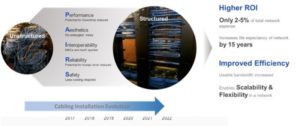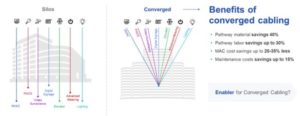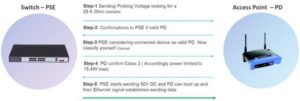 As networks get smarter, network infrastructure needs to get simpler. Once IoT (Internet of Things) applications scale up, the number of connected devices will increase exponentially, making infrastructure provisioning increasingly complex. The connected world needs a solution that converges power and data infrastructure to cater to triple-play services and power consumption demands of edge network assets. A smart way to do this is to re-engineer category cable design and technical standards for enhanced business and operational performance.
As networks get smarter, network infrastructure needs to get simpler. Once IoT (Internet of Things) applications scale up, the number of connected devices will increase exponentially, making infrastructure provisioning increasingly complex. The connected world needs a solution that converges power and data infrastructure to cater to triple-play services and power consumption demands of edge network assets. A smart way to do this is to re-engineer category cable design and technical standards for enhanced business and operational performance.
Power over Ethernet (PoE) is the new buzzword, which will shape the network ecosystem of tomorrow. Human civilization is on a pursuit to digitize the globe. Be it digital transformation, Internet of Things (IoT), mobility of the future, NextGen wireless (such as 802.11ac Wave 2 and 802.11ax), and smart devices solutions and deployments have been a testament to rapid growth in the period 2015-20.
Globally, data usage is growing at unprecedented rates, driven by the multiplier effect of more users, more devices per user, more content per device. In 2015 annual global IP traffic crossed 1 Zettabyte (ZB), and is expected to exceed 4 ZB in the next five years (1ZB = 1021TB). Per capita data consumption is set to multiply nearly five times in the next three years!
Exponential growth in both consumer and enterprise led data consumption demands more digitization and technology innovation. This data driven civilization is 24X7 ON, tracking, monitoring, producing data and among this connectivity is the key to make all this efficient and seamless.
IoT Market Growth and Drivers
The global Internet of Things (IoT) market1 will be worth US$1.1 trillion in revenue by 2025 as market value shifts from connectivity to platforms, applications and services, according to new data from GSMA Intelligence. By that point, there will be more than 25 billion IoT connections (cellular2 and non-cellular), driven largely by growth in the industrial IoT market. The Asia Pacific region is forecast to become the largest global IoT region in terms of both connections and revenue3
IoT revenue opportunity is shifting away from simply connecting devices to addressing specific sectors with tailored solutions, and successful ecosystem players will need to adapt their business models in line with these market trends. Connected industry equipment, smart city and smart energy projects constitutes more than 50% of the current IoT projects.
-As per Cisco, number of connected devices registered in 2015 was nearly 15 billion, by 2020F its likely to reach 50 billion.
-By 2020F 5 billion people would be connect through connected devices, each person using 10 devices on an average – World Economic Forum
-The contribution of Industrial Internet will be nearly US$15 trillion by 2030F as per Global Electronics
Like these data points, IoT as a digitizing catalyst is itself amazing, exponential and puts forward opportunities for tremendous growth and better living.
In the future it is clear then IoT will be a major driver for data growth. Some of the major technological trends which are estimated to propel IoT to the forecasted tipping point are:
-Decreasing cost per CPU memory and storage, this enables better data storage and analytics
-Wider acceptance and wide availability of devices such as sensors
-Reduced cost of data plans, more cash available for investment in large processing systems
-Development of cloud and edge computing, these offer flexible data repositories options
-Convergence of information technology, operational excellence and connected devices
Structured and Converged cabling is the solution
Structured Cabling is the standardized architecture and components for communications cabling specified by the TIA/ISO standards used as a voluntary standard by manufacturers to ensure interoperability. Structured Cabling is defined as building or campus telecommunications cabling infrastructure that consists of a number of standardized smaller elements (structured). A properly designed and installed system that provides a cabling infrastructure that delivers predictable performance as well as has the flexibility to accommodate moves, adds and changes; maximizes system availability, provides redundancy; and future proofs the usability of the cabling system. A structured cabling system is flexible, reliable and highly efficient for moving, adding and changing the infrastructure as the network grows.

-The IoT environment continues to evolve and cabling is one of the critical factors in determining usable bandwidth in a network and its operational costs
-Choice of cabling can have a big influence on temperature rise and energy costs
Benefits of structured cabling compared to unstructured cabling:
-Easy scalability and adaptability to future growth needs
-Easy to install, repair and replace
-Standardized and modular design enables quick and easy replacements and upgrades.
-Easy integration and support to multimedia content and enterprise solutions such as video conferencing
-Unified and modular cabling helps in easy diagnosis and monitoring
-Overall higher ROI and improved efficiency

Similarly, the case of converged communications infrastructures brings in a series of benefits. Traditionally various applications such as high speed Ethernet, VoIP, HD video streaming, HVAC and advanced metering have been operated in silo’s. Converged cabling solutions merges all these applications over a common cabling infrastructure. By using a unified cable medium and transmitting signals using a common protocol allows data single point control and data analysis features. Converged cabling used in conjunction with IoT can help achieve enhanced performance and value. This helps in achieving true machine to machine communication.
The distinction between data and equipment types into their own separate cabinets and outlets, makes it easy to streamline connectivity. One of the most common mistakes in unstructured cabling is running power cables in proximity to data cables. This leads to creation of noise in network and thus reduce efficiency. Structured and converged cabling takes such instances into account from the start and helps achieve structured network setup.
PoE: Multiple services, Unified cabling
Power over Ethernet (PoE) is popular LAN switching technology. This technology helps in providing DC power at endpoint over copper Ethernet cable. DC power is transmitted from Power Sourcing Equipment (PSE) over the existing twisted pair Ethernet cable. This twisted pair Ethernet cable enables connectivity in the Powered Devices (PD) such as IP phones, video cameras, wireless access points, point-of-sale machines, access control card readers, LED luminaires, and other industrial and building automation applications. This technique helps in reducing the capital expenditure and in turn brings down the return of investment (ROI) of the project.
Step by step overview of power transfer from source to device: (Signature detection process)

PoE capability evolution
PoE devices power supply has been standardized according to IEEE 802.3 generation specifications. The PoE life cycle generation is represented by the short form “af,” or PoE, “at” or PoE+, and “bt” or PoE++.

Responding to growing market and end user demand, new IEEE 802.3bt standard offers a host of new features and capabilities, such as support for highly efficient 4-pair power delivery, and channel definitions for 2.5 gigabits per second (Gbps), 5 Gbps, and 10 Gbps PoE operations, among others. Ratified in September 2018, the new specification also boosts the maximum power that power sourcing equipment (PSEs) are capable of by a factor of three, expanding it from 30 to 90 watts, and elevates the power level for powered devices (PDs) to 71.3 watts. Additionally, IEEE 802.3bt doubles the number of supported classes from four to eight, addressing Type 3 and 4 devices for both PSEs and PDs between 4 – 90 watts and 3.84 – 71.3 watts respectively.
Li-Fi: NextGen PoE for future
Li-Fi is an innovative way of wireless communication that uses LED lights to transmit data wirelessly. The technology uses Visible Light Communication (VLC), a medium that uses visible light between 400 and 800 TeraHertz (THz – It works just like switching a torch on and off according to a certain pattern can relay a secret message, flicking an LED on and off at extreme speeds can be used to write and transmit things in binary code. This means that it accommodates a photo-detector to receive light signals and a signal processing element to convert the data into ‘stream-able’ content.
An LED light bulb is a semi-conductor light source meaning that the constant current of electricity supplied to an LED light bulb can be dipped and dimmed, up and down at extremely high speeds, without being visible to the human eye. The tiny changes in the rapid dimming of LED bulbs are then converted by the ‘receiver’ into electrical signal. The signal is then converted back into a binary data stream that we would recognize as web, video and audio applications that run on internet enables devices. It is a Visible Light Communication (VLC) medium and utilizes visible light of electromagnetic spectrum. The visible spectrum ranges 400 – 800 THz is utilized for data transmission and illumination. Data is transmitted as fast pulses of light in wireless medium. Key components of a basic Li-Fi system include:
-An illuminating device such as LED
-A receiving device as silicon photodiode, to receive visible light

The input data is encoded as 0 or 1 into VLC, 0 means OFF and 1 means ON. ON or OFF operation is done as flickering operation of LED in ultra-fast pace not noticeable by human eye. In the receiving end a sensor such as silicon photodiode decodes the signal and reflects it in output device.
Global Market Insights recently released a report predicting the Li-Fi market will reach USD 9 Billion by 2023. It can support both enterprise networks and mobile wireless networks and provide a partial energy-efficient solution to the high energy power consumption of base stations. With the ability to transmit power and data via a single networking cable, PoE eliminates the expense of installing additional electrical circuitry. If network installers can rely on PoE to deploy LED lighting, and Li-Fi can rely on existing LED lights to transmit Li-Fi, PoE can easily be used to power Li-Fi.
Possible use cases of LiFi:

Conclusion
PoE has become a vital part in Global digital transformation journey. The advantages of structured cabling and PoE are multifold and upcoming industry trends indicate wider acceptance of same. Twisted Pair is best suited cabling media to support emerging applications such as data, video and voice communications, as well as simultaneously powering communication equipment, such as wireless access points, cameras and LED lighting etc. A Cat 6A onward can successfully transmit data across the full 100 m channel not only provides an extra margin of performance, but also supports a wider range of data centre and network configurations.
Recent Random Post:


















